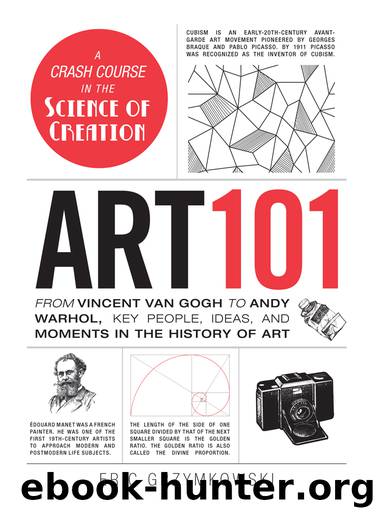Art 101 by Eric Grzymkowski

Author:Eric Grzymkowski [Grzymkowski, Eric]
Language: eng
Format: epub, mobi
ISBN: 978-1-4405-7155-8
Publisher: F+W Media
Published: 2014-04-07T04:00:00+00:00
SURREALISM SPREADS AND DIVIDES
Throughout the 1930s, Surrealism’s notoriety as an art form began to spread across Europe and became visible to a wider audience. Surrealist landscape paintings such as René Magritte’s Voice of Space (1931) and Salvador Dalí’s The Persistence of Memory (1931) made Surrealism recognizable. In 1936, both London and New York hosted international Surrealist exhibitions. In 1937, in homage to its vast influence or perhaps as a joke, Max Ernst finished his painting The Triumph of Surrealism. In 1938, the Galerie Beaux-Arts in Paris gathered 300 Surrealist paintings, objects, collages, photographs, and installations made by more than sixty artists from different countries. However, despite this outward success, there were inward divisions within the movement.
André Breton was known to be dogmatic in approach and was often prone to exclusionary tendencies. The results of such authoritarianism erupted into a series of internal disputes and eventual splits within the group. Louis Aragon, who had collaborated with Breton during the early years of his rise to social and intellectual prominence, began to move away from Surrealism. Wanting a more politically motivated art form, in the 1930s he became an active member of the French Communist Party and, along with other former Surrealists, founded the Association of Revolutionary Writers and Artists in 1932. Another close collaborator, the poet Paul Éluard, remained tied to the group until the early 1940s when he also left to join the French Communist Party.
Georges Bataille, having accused the Surrealists of possessing an “Icarian complex” that placed too much emphasis on the desire to soar rather than confront the base matter below, wished to break away completely from Surrealism’s strict reliance on the opposition between high and low. Bataille’s thinking would become known as base materialism.
Another well-known figure who moved away from Surrealism was the Swiss sculptor Alberto Giacometti. While he wouldn’t officially break with Surrealism until after World War II, in the mid-1930s, his art was already moving away from the Surrealist-derived imagery of dream and its abstract forms. Instead, his works were becoming more attached to figurative representations. His elongation of the figure to the point of near nonexistence, what was to become known as bare realism, became emblematic of this shift in Giacometti’s artistic practice.
After Surrealism’s peak of popularity in the 1930s, with the arrival of war, artistic and intellectual production was overshadowed by the demands of wartime. In the post-war period, with the rise of new European and American artistic forms and intellectual currents, Surrealism as an organized movement continued to wane. With the death of Breton in 1966, a certain era of Surrealism had in fact come to a close. However, it continued to have significant influence for artistic groups of the 1950s, ’60s, and ’70s such as the Situationist International, and particular artists such as Louise Bourgeois.
Similarly, as women were often viewed as the psychic representative of the irrational, they were frequently depicted in relation to the disturbing power the subconscious could have over ordinary things, the “dark” side of the subconscious. However,
Download
This site does not store any files on its server. We only index and link to content provided by other sites. Please contact the content providers to delete copyright contents if any and email us, we'll remove relevant links or contents immediately.
The Secret History by Donna Tartt(18166)
Red Sparrow by Jason Matthews(5198)
Harry Potter 02 & The Chamber Of Secrets (Illustrated) by J.K. Rowling(3556)
In a Sunburned Country by Bill Bryson(3369)
Drawing Cutting Edge Anatomy by Christopher Hart(3290)
Figure Drawing for Artists by Steve Huston(3272)
The Daily Stoic by Holiday Ryan & Hanselman Stephen(3110)
Harry Potter and the Prisoner of Azkaban (Book 3) by J. K. Rowling(3110)
Japanese Design by Patricia J. Graham(3002)
The Roots of Romanticism (Second Edition) by Berlin Isaiah Hardy Henry Gray John(2820)
Make Comics Like the Pros by Greg Pak(2758)
Stacked Decks by The Rotenberg Collection(2687)
Harry Potter and the Deathly Hallows (7) by J.K. Rowling(2550)
Draw-A-Saurus by James Silvani(2504)
Tattoo Art by Doralba Picerno(2488)
On Photography by Susan Sontag(2485)
Foreign Devils on the Silk Road: The Search for the Lost Treasures of Central Asia by Peter Hopkirk(2388)
Churchill by Paul Johnson(2364)
The Daily Stoic by Ryan Holiday & Stephen Hanselman(2344)
